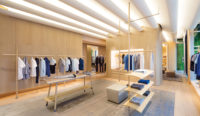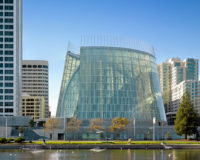Orl'ans, France
A different kind of FRAC Centre (Les Fonds R'gionaux d'Art Contemporain) opens September 14 in the historic city of Orl'ans, France'it is the first of the some two dozen regional cultural institutions to be devoted to architectural exhibitions as well as art. Dubbed Les Turbulences, the complex features a quirky, digitally sculpted new extension appended to 18th- and 19th-century buildings that were once a military supply depot. The project, which was designed by the Paris-based architects Jakob + MacFarlane, involved the restoration and renovation of the existing U-shaped complex, plus a partial demolition of one wing to create a sloping and dipping courtyard for a new aluminum-clad, parametric form. The arresting addition, with its snout-like chimneys, energetically beckons visitors to this tight site bounded by a highly trafficked road, its scale unexpectedly and oddly in keeping with the historic environs.
Initiated in 1982 to create decentralized arts centers throughout France, the FRAC program recently has been commissioning new buildings designed by innovative architects to generate appropriate settings for its contemporary programs. Jakob + MacFarlane, Odile Decq in Rennes, and Kengo Kuma in Marseilles, are the first architects to have completed works; more are to follow. But uniquely in Orléans, FRAC decided to devote a new architectural center to the exhibition of its collection of 15,000 international architectural drawings and 800 models—along with a number of works by artists. A special focus of the collection is a panoply of utopian and experimental architectural projects conceived since the post-War period (particularly in the 1960s and 1970s) by Yona Friedman, Claude Parent, and Archigram among others.
Adding to the significance of the Orléans location is the fact that ArchiLab, an international conference of young experimental architects, has had its base of operations on this site since it was first organized in 1999. ArchiLab’s ninth meeting and exhibition Naturalizing Architecture, which focuses on the interaction of science and architecture, begins September 14, providing an appropriate topic for the inauguration of Les Turbulences.
Dominique Jakob and Brendan MacFarlane (who have taken part in past ArchiLab events and expositions) designed the organic, digitally generated, free-form spaces of the extension to accommodate the museum entrance, admissions, a café, temporary installations, and a video area. As important is their sensitive restoration and renovation of the stucco-walled, limestone, and brick structures with red-tile roofs for permanent galleries (4,000 square feet), and temporary exhibition spaces (12,000 square feet). By exposing the column-and-beam structure of the older picturesque ensemble in which to display the architectural drawings, models, and related art works, they revealed the spare, modern quality of the older buildings themselves. Since each wing’s structural grids were not all aligned in one orthogonal plan, but are cranked slightly away from each other, the two partners seized upon the “clashing geometries,” and a “deformation” of spatial flow as an impetus for the new extension’s design.
For more details, see RECORD's forthcoming October issue.
People |
Products |



















